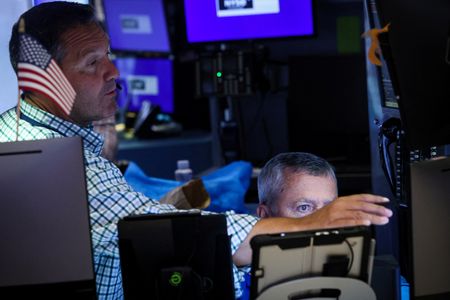By Stephen Culp
(Reuters) -U.S. stocks added a third straight day to their sell-off on Friday as lingering chaos related to a global technical outage caused by a software glitch added uncertainty to an already-anxious market.
The far-reaching, worldwide tech outage disrupted operations across multiple industries including airlines, banking and healthcare after the glitch in cybersecurity firm Crowdstrike’s software caused Microsoft’s Windows operating system to crash.
While the flaw was identified and fixes deployed, technical issues continue to affect some services.
Crowdstrike shares slid 12.1%, while rival cybersecurity firms Palo Alto Networks and Sentinal One were up 1.6% and 8.5%, respectively.
All three major U.S. stock indexes were lower, with the Dow Jones Industrial average suffering the worst of it.
On a weekly basis, both the Nasdaq and the S&P 500 were on track for their worst week since April, while the Dow, having reached a series of all-time closing highs earlier in the week, appeared primed to post a Friday-to-Friday gain.
The tech-heavy Nasdaq seemed headed toward snapping its six-week winning streak.
“If you’re trying to fly today it was not a fun day, but overall for markets it doesn’t appear to be too big of a hiccup,” Ryan Detrick, chief market strategist at Carson Group in Omaha, Nebraska. “After a historic rally since May, this weakness seems to be just the market catching its breath.”
“You have to be kind of impressed how market participants have taken today’s huge outages in stride,” Detrick added.
The smallcap Russell 2000 – a beneficiary of a recent pivot away from megacap growth stocks – was last off 0.6%.
The CBOE Market volatility index, considered a gauge of investor anxiety, touched its highest level since late April.
Nvidia shares led a sell-off in chips. The Philadelphia SE Semiconductor index underperformed the broader market, tumbling 2.8%.
Elsewhere, Federal Reserve Bank of New York President John Williams reiterated the central bank’s commitment to bringing inflation down to its 2% target.
Financial markets have priced in a 93.5% likelihood that the Fed will enter a rate-cutting phase at the conclusion of its September meeting, according to CME’s FedWatch tool.
At 2:33 p.m. EDT, the Dow Jones Industrial Average fell 387.25 points, or 0.95%, to 40,277.77, the S&P 500 lost 40.52 points, or 0.73%, to 5,504.07 and the Nasdaq Composite dropped 151.31 points, or 0.85%, to 17,719.92.
Second-quarter earnings season approaches the end of its first full week, with 70 of the companies in the S&P 500 having reported. Of those, 83% have beaten consensus, according to LSEG.
Analysts now see aggregate year-on-year S&P 500 earnings growth of 11.1%, an improvement over the 10.6% estimate as of July 1.
Next week, a swath of high-profile results is expected from Tesla, Alphabet, IBM, General Motors, Ford and a host of other companies.
“It’s early in earns season, but things have been impressive,” Carson Group’s Detrick said. “But the big boys are starting to report next week and what we want to hear is how strong the consumer is and what’s the outlook for future economic growth.”
Eli Lilly advanced 0.7% after China approved its weight-loss drug tirzepatide, while Intuitive Surgical jumped 8.8% after a second-quarter results beat.
Travelers tumbled 7.3% on lower-than-expected growth in net written premiums.
Netflix fell 0.9% in choppy trading after the streaming giant cautioned third-quarter subscriber additions would be lower than a year earlier.
Oilfield services provider SLB rose 1.7% after strong second-quarter profit.
Declining issues outnumbered advancing ones on the NYSE by a 2.14-to-1 ratio; on Nasdaq, a 1.77-to-1 ratio favored decliners.
The S&P 500 posted 27 new 52-week highs and 4 new lows; the Nasdaq Composite recorded 39 new highs and 81 new lows.
(Reporting by Stephen Culp in New YorkAdditional reporting by Lisa Pauline Mattackal and Ankika Biswas in BengaluruEditing by Devika Syamnath and Matthew Lewis)





